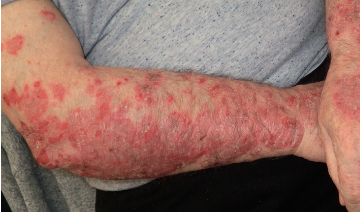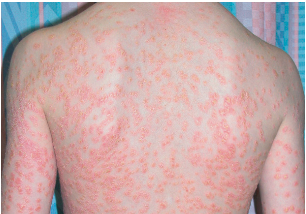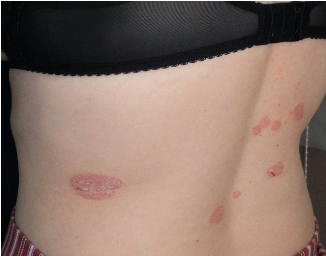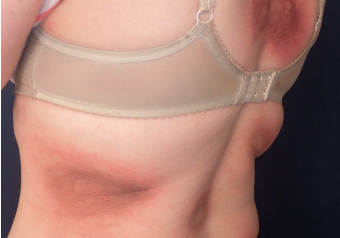A clinical overview of psoriasis and the ‘psoriasis disease spectrum’, including case studies and potential treatment considerations
The exact cause of psoriasis is currently unknown, but it is felt to be a combination of genetic, autoimmune, and environmental factors. Psoriasis is diagnosed clinically as there is no blood test or histological features that can definitely diagnose psoriasis. Psoriasis is now classified as ‘psoriasis disease spectrum’. In this spectrum, over-activity of T-lymphocytes and cytokines can lead to a pro-inflammatory state. This not only affects the skin, hair, and nails, but it can also be associated with arthritis, endothelial damage causing atherosclerosis, the metabolic syndrome, and mental health issues. Psoriatic arthritis occurs in 15-to-25 per cent of patients with chronic plaque psoriasis.
Although there is no cure for psoriasis, there are many safe, effective treatments now available. There are many different types of psoriasis (Table 1). The majority of adults with chronic, stable plaque psoriasis can be managed in general practice with emollients, lifestyle advice, and a combination of calcipotriol, (a vitamin D analogue), and betamethasone (a potent topical steroid). This is available as Dovobet, Enstilar Foam or Wynzora Cream. These help in approximately 60-to-70 per cent of patients. For those who fail to respond, a trial of ‘short contact dithranol’ can be very safe and effective even in children, and can result in long-term remission of months or years in the majority of patients.
Severe extensive cases may have to be referred to a dermatology department for phototherapy, oral treatments such as methotrexate, or systemic treatments such as the newer biological agents.
The two case histories in this article demonstrate some of the key features when managing the psoriasis disease spectrum in primary care.
Psoriasis
- Chronic plaque psoriasis
- Small plaque psoriasis
- Guttate psoriasis
- Nail psoriasis
- Flexural psoriasis;
- Palmoplantar, pustular psoriasis (also known as Palmoplantar pustulosis)
- Generalised pustular psoriasis
- Erythrodermic psoriasis
- Psoriatic arthritis
Table 1: Types of psoriasis
Case 1
‘Mary’ is a 55-year-old mother of grown-up children, who presented with a recent flare-up of her chronic plaque psoriasis that she has had for many years. She lives alone and is a retired secretary. She has a background history of hypertension, hypercholesterolaemia, migraine, osteoarthritis, and depression. Her sister has arthritis. She gave up smoking one year ago after having an angiogram, which showed one vessel disease. She says she drinks socially.
In the last six months her psoriasis, which was mild, has become more scaly and extensive and is now affecting
her scalp, face, ear canals, chest, and limbs. It is not particularly itchy. She has some mild associated hair loss.
She also has pain in her right knee for
the past three months.
On examination, she was overweight with a BMI of 46. Her blood pressure was 170/100. A random blood sugar was normal, but her HbA1c was 46 six months earlier. Her total cholesterol was 7.5mmole
/l and her HDLs were 1.5mmole/l.
She has thick scales on her posterior scalp with mild hair thinning. She has a lot of dandruff scale, obvious on her black jacket. She has a red, scaly rash in her nasal labial folds, her medial cheeks, her eyebrows, and on her anterior hairline. On removing her shirt there is a ‘snow storm’ of scale. She has an extensive scaly rash on both forearms and lower legs (Photo 1). She has a few small patches of psoriasis on her trunk. She also has a mild, red, non-scaly rash on her perianal area, which is excoriated from scratching. Examination of her nails shows some pitting and onycholysis (separation of the distal nail from the nail bed). Examination of her right knee shows some swelling, stiffness, and a small effusion.
She is on the following medication:
- Pregabalin;
- Xanax 500mcg prn;
- Xpram two tablets three times
a day PRN;
- Rosuvastatin 20mg daily;
- Pantoprazole 40mg daily;
- Bisoprolol 5mg daily;
- Nuseals aspirin.
She has also been using 1 per cent hydrocortisone cream on her face and vulva, polytar shampoo on her scalp, and Enstilar foam on her body, which are not helping, so I asked her to stop all these.

Case 1 discussion
This lady has an obvious flare-up of her chronic plaque psoriasis. She also has features of seborrhoeic dermatitis on her face and perianal area. This flare-up may have been precipitated by the recent introduction of bisoprolol (a beta-blocker) for her hypertension (Table 2). Blood tests showed that she has a raised gamma-glutamyl transferase (GT) and mean corpuscular volume (MCV), and on closer questioning she admitted to drinking a bottle of wine (or two) most nights, which may also have been aggravating her psoriasis.
I stopped her beta-blocker and put her on a calcium channel blocker instead. I doubled her statin dose. I also referred her to the community alcohol service and gave her a phone number to contact the AA. I referred her to the dietitian for weight control and a Mediterranean diet. I encouraged her to join the aqua aerobics group, of which she was a member before, as this might help her to lose weight and make new friends.
In addition to her chronic psoriasis, she also has features of the metabolic syndrome with obesity, hypercholesterolaemia, hypertension, and pre-diabetes. Patients with the metabolic syndrome are at increased risk of stroke and myocardial infarction and have a two-fold increased risk of dying from such an event compared to those without the syndrome. There is also an increased risk of depression and substance abuse in patients with psoriasis and these two problems can further aggravate or precipitate psoriasis.
I advised her to moisturise liberally with ‘Doublebase emollient’. I encouraged her to use Nizoral shampoo three times a week and to leave it soak in for three minutes before rinsing it out. I suggested that she wear light-colour clothing to help disguise her dandruff. I prescribed tacrolimus 0.1 per cent (Protopic) ointment for the rash on her face, anterior hairline, ears, and perianal skin, while advising her that this was an off-label indication for this ointment (Table 3). I asked her to apply this twice a day for three weeks and then twice a week after that to prevent relapse. I warned her that this ointment might cause a transient irritation and reddening of the skin in the first week of use in up to 50 per cent of patients, but this usually settles on the second week.
Since she had failed to respond to Enstilar foam, I decided to try her on ‘short contact’ dithranol therapy. The precise mode of action of dithranol (also known as anthralin) is still to be confirmed, although it has been shown to inhibit DNA replication, keratinocyte hyperproliferation, granulocyte function and, in addition, may exert an immunosuppressive effect. It was commercially available as Dithrocream and it came in five different strengths, from 0.1 per cent up to 2 per cent. However, this is no longer available in Ireland. Instead, my local pharmacist was able to source 3 per cent dithranol ointment. I asked the pharmacist to dilute this down with Lassar’s paste to make four strengths, (0.375 per cent, 0.75 per cent, 1.5 per cent and 3 per cent). I instructed the patient to apply the 0.375 per cent ointment to all the scaly areas on her scalp and body (but not to her face or groin) for 30 minutes daily for one week. Each week she should increase the strength until she got up to the maximum strength of 3 per cent. I advised her that if her skin got red and sore, she should stop the dithranol for a few days until this sunburn-type reaction settled and then go back down to the previous strength. I warned her that dithranol causes a brown staining of the skin, but this usually clears within two weeks of stopping the treatment (Photos 3 and 4). It can also stain clothing, towels, and furniture, so she was advised to be careful not to stain anything valuable for the 30 minutes it is in contact with her skin. I gave her a patient information leaflet on how to use dithranol for 30 minutes daily until the skin felt smooth and all the scaly rash was gone, although there will be residual staining from dithranol. This usually takes four-to-six weeks.
On review a month later, her scalp, face, ears and groin rash were completely clear. Her hair was regrowing. The plaques on her body were stained a brown colour, but were 90 per cent clear and she was up to the 3 per cent dithranol every day for 30 minutes. She had abstained from alcohol for the previous month and had lost four kilos in weight by reducing sugar and fats in her diet and increasing her exercise. She was awaiting a dietitian review. Her blood pressure was reduced to 140/90. I arranged for her to come back a month later for targeted control of her weight, blood pressure, cholesterol, and blood sugars. An x-ray of her right knee showed features suspicious of psoriatic arthritis, so I referred her to a rheumatologist.
Case 2
‘John’ is an 18-year-old apprentice mechanic living at home. He smokes
10 cigarettes per day and drinks 10-to-15 pints of beer most weekends. He presents with a generalised, non-itchy, scaly rash, mostly on his trunk, for the past four weeks. It started after a sore throat, which was treated with Augmentin from a ‘walk-in clinic’. He was told over the phone that he had now developed an ‘allergic reaction’ to penicillin, which he should never take again.
When I examined him, he had multiple, small, slightly scaly plaques, each measuring one-to-two centimetres, mostly on his trunk,
but a few on his face and upper thighs (Photo 2). These were evenly and symmetrically distributed all over his chest and back. His scalp and nails were clear. His ENT examination was normal.

Case 2 discussion
John had a quite typical presentation of guttate psoriasis, which is more common in younger people and often precipitated by streptococcal throat infection. Upon clinical review, I reassured him that he was not allergic to penicillin, but I advised him to stop smoking, as this can predispose him to developing more throat infections and further attacks of guttate psoriasis. I gave him our patient information leaflet on smoking cessation and referred him to the HSE smoking cessation officer.
I reassured him that guttate psoriasis usually clears spontaneously within six-to-12 weeks and, as there was little or no itch, he did not need any treatment apart from a bland emollient such as Epaderm cream. I prescribed 1 per cent hydrocortisone ointment for a few small plaques on his face, as he was going to his brother’s wedding in two weeks’ time. I advised him to reduce his alcohol intake and to re-join his local football club to get fit. I advised him that if his rash did not clear up after 12 weeks, I might try him on Enstilar Foam or refer him for phototherapy. I advised him that some patients can get further attacks of guttate psoriasis and approximately one-third
of these patients will go on to develop chronic plaque psoriasis.
* For further information on psoriasis, seborrhoeic dermatitis, and many other common skin problems, see Dr David Buckley’s new book titled Textbook of Primary Care Dermatology.
Dr Buckley gave a presentation on psoriasis at the Primary Care Dermatology Society of Ireland’s 2023 Annual Scientific Meeting, which was held in Kilkenny on 3 and 4 March. For more information see: www.pcdsi.com. ?


References available on request







